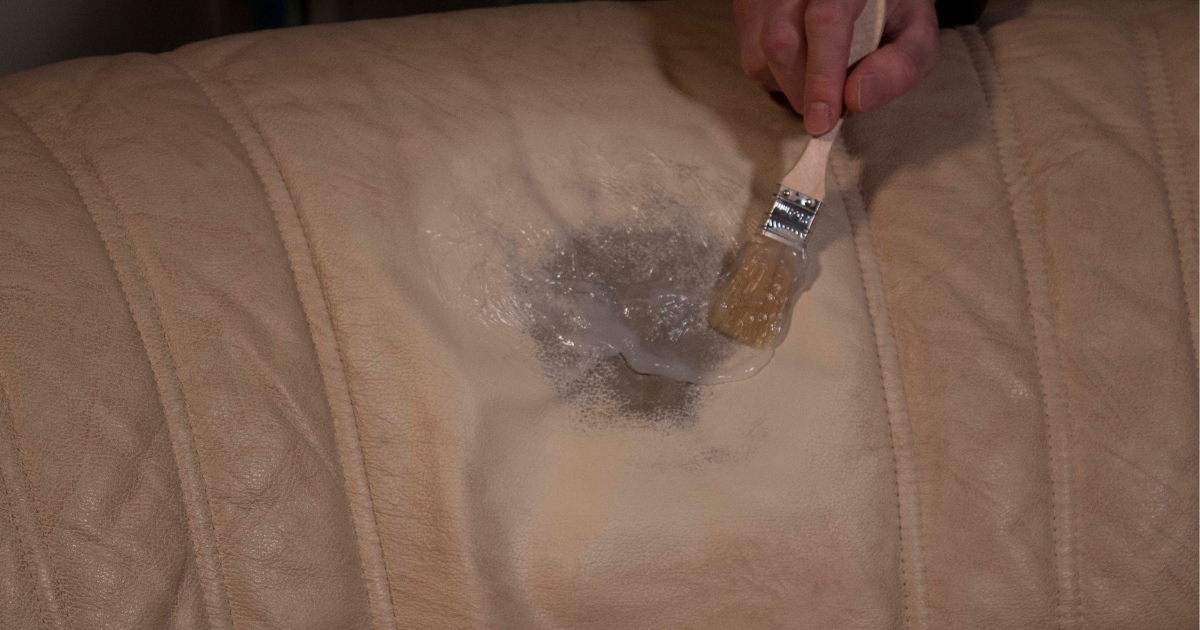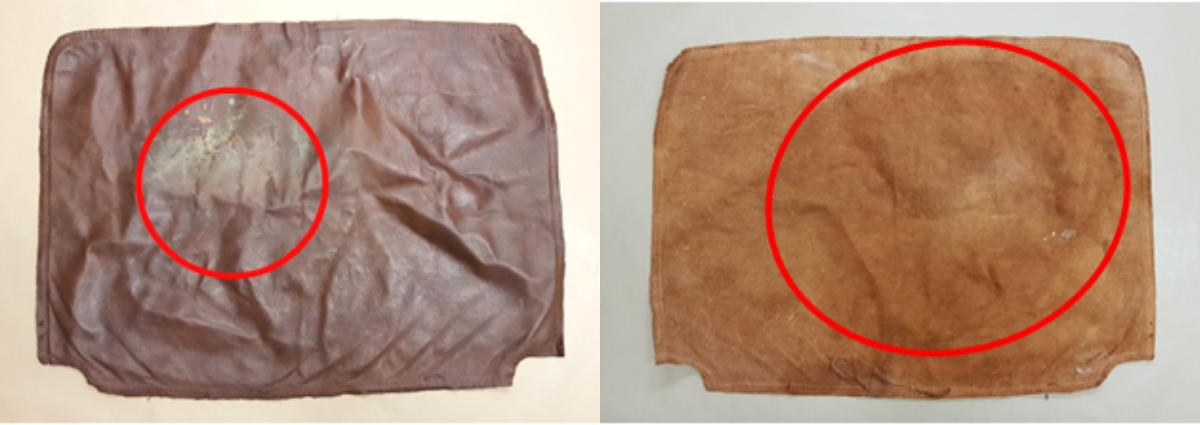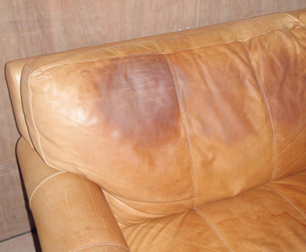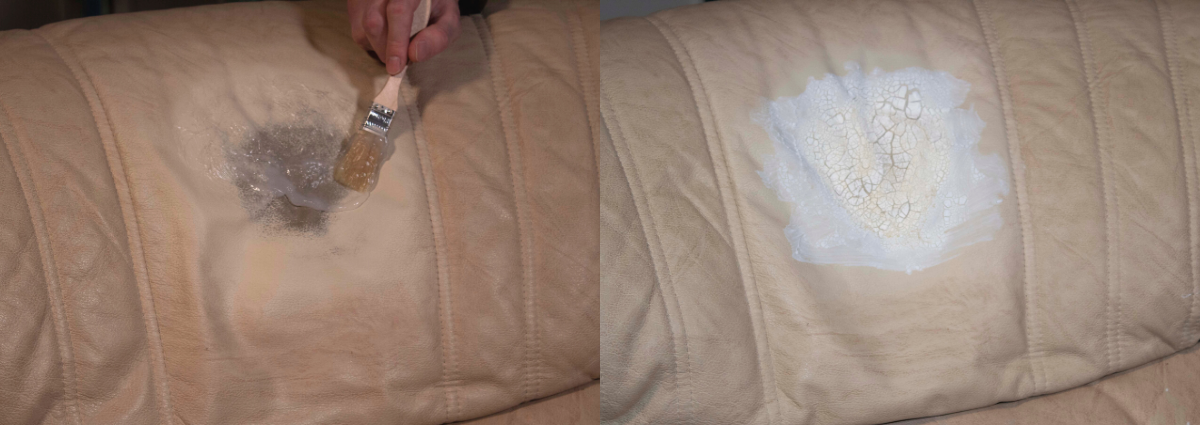-
You have no items in your shopping cart.


The content below is for professional users of our products. If you need to degrease your leather, use our Leather Degreaser.
One of the biggest problems when it comes to re-colouring and refinishing leather is grease contamination. As you use the leather, natural oils from your skin can cause the finish and pigmented coatings on the leather to deteriorate. As this happens, it leads to tiny micro cracks where the contamination can soak into the fibre structure of the leather. The grease will then spread underneath the pigmented layer and start to make the leather perish and rot.
The worst thing about grease is that if you can see that there is contamination on the surface of the leather, the contamination which has soaked into the leather (the flesh/suede side), will be much larger in area. This is because the grease soaks into the leather and spreads outwards. See the picture below of this piece of leather taken from a sofa back cushion which has been flipped over to see the extent of the contamination of the back compared to the front.

If left untreated, the grease contamination will lubricate the fibres of the leather which can cause the fibres to pull apart more easily and eventually cause heavier cracking to the pigmented coatings.
If you do not identify that the leather is contaminated with grease and you proceed to re-colour without proper decontamination, the Leather Colourant and Leather Finish are likely not to adhere to the leather properly and would stay tacky and will peel off, leading to a failed repair.
When absorbent leather becomes contaminated from grease, it is a bit easier to identify and diagnose. As the leather is of an absorbent nature, anything which absorbs into it will normally darken the leather. Grease contamination is no different, the tell-tale signs of greasy areas can be seen instantly by looking at the common areas where grease would normally build up and accumulate; the head and neck areas, hand and elbow areas on furniture are all the usual suspects. With absorbent leather, the extent of the contamination can be easily identified by how dark the leather is in those places.

Knowing that greasy leather is primarily caused by skin contact, it would be easy to assume that the main areas of grease contamination would be the afore mentioned usual suspected areas. However, do not assume that these are the only areas where grease can accumulate. People may lie on their sofa with their feet up on the seat cushions for example, so seating areas may need to be degreased before any colour work is undertaken. In fact, when any area of leather is in need of restoration it may be prudent to assume that it could be greasy until you conclude that it is not.
Some tell-tale signs of contaminated leather can be:
The leather underneath the pigmented coat will look darker. Think of when absorbent leather gets wet, it turns dark. It can also look quite dull.
If you scratch the dark area with a fingernail it turns lighter where you scratched it. Do not get this confused with pull up leather.
When you heat up the area with a hairdryer you can sometimes see that the surface of the leather will glaze over with a shiny residue. This is the grease melting with the heat.
The feel of the leather can be a good indication. If the leather is heavily contaminated it will feel greasy to the touch or tacky and may also smell.
In some extreme cases you can even scrape the grease from the surface.
We have two different types of degreaser; both have thorough instructions of how to use them on their product pages, so it’s definitely worth giving them a read after reading this blog.
The instructions outline the best way to use each product, however, there are a few more things you could try to facilitate in the extraction of grease:
Liquid Leather Degreaser – We would normally advise to use this on lightly soiled greasy areas where the contamination is not deep within the fibre structure of the leather. Or for use on absorbent leathers where you can see where the contamination is from the dark areas.
The Liquid Leather Degreaser is remarkably good at removing surface stains. But it also can be used to successfully remove a heavy build of grease contamination. Being a non-polar solvent, this means amongst other things that it has a quick evaporation rate. You can use this to your advantage.
A good technique to speed up the grease removal process is to use a hairdryer in between coats of the Liquid Leather Degreaser. If the leather is saturated with the product, applying moderate heat will quicken the evaporation rate and, as it does so, will in essence ‘suck’ the grease to the surface of the leather where you can wipe it away with the next application of the Liquid Leather Degreaser while repeating the process until all the grease has gone. I am not sure exactly how it works but it’s something to do with (2 spaces)vapour pressure, molecular energy and evaporation rate, along with some other science stuff.
Leather Degreaser - Our paste degreaser is traditionally used on heavily contaminated greasy leathers. But with the method outlined above with the Liquid Leather Degreaser, I personally like to use that technique in conjunction with the paste Leather Degreaser on pigmented leather. Because the grease soaks into the leather and spreads outwards, you will need to determine the size of the affected area. The paste degreaser can show you this. To speed up the whole degreasing process, I like to strip back the old coatings with our Leather Prep. This exposes more of the aniline leather underneath and will allow more grease to be absorbed into the product.
I would strip back a larger area than what I can see is greasy, use the Liquid Leather Degreaser and hairdryer method and then apply the Leather Degreaser paste over the area which I have stripped back and leave to dry.

Once dried, you can assess the area. Look at where the powder has dried to a yellow colour compared to a lighter or whiter colour. If the yellow powder corresponds to where the pigmented coat was originally stripped back to, this will generally indicate that there may be more grease which is larger in diameter than what has been stripped back. The pigment which has not been removed is acting as a barrier preventing migration of the grease to the powder.
The Leather Degreaser is acting as a visual indicator as to the size of area which needs to be decontaminated. I will always repeat the process by first of all using the Leather Prep to strip back more of the pigmented coat. When the paste dries to a yellow powder within the diameter of the stripped back area, it’s fair to say that there is no more grease beyond the pigment which has not been stripped back. When this is the case, I continue to degrease only where the yellow powder remains.
One more thing to mention which repeatedly crops up when discussing degreasing leather is the fact that after degreasing, many people believe that the process strips out the natural fat liquors of the leather and makes the leather ‘hard’ or like ‘cardboard’. While it is true that some leathers can feel like this after the degreasing process, this is not down to loss of natural fat liquors; this occurrence can be easily rectified. Indeed, it is true that technically, the degreasing process will inevitably remove some natural fat liquors; but the amount that will be lost in the process is negligible to the integrity of the leather or repair. Because the leather is saturated with grease, all we are doing is removing excess oil which is slowly rotting the leather and, by stopping the degreasing process when the excess oil is no longer migrating, this will ensure that minimal natural oils are lost.
The stiffness of leather related to the degreasing process is down to the fibre structure of leather. Leather is tanned to be able to withstand multiple wetting and drying processes. The degreasing process is indeed wetting and drying the leather multiple times. Remembering that as leather is a fibrous structure, as the fibres get wet, they will swell, and then as they dry, they will shrink again. It is this, which tightens up the fibres. To rectify, the leather needs to be massaged to try to recreate the dry milling step in tanning leather. Simply scrunch, massage and manipulate the leather with your hands. This will slightly pull apart and free up the fibres and soften the leather considerably.
Did you know that the Liquid Leather Degreaser can be used as a ‘sticky stuff’ remover? Residues from the likes of sticky tapes, any solvent based glues, and even the likes of some sticky food residues can easily be wiped away from an array of surfaces with our Liquid leather Degreaser! Simply test on an inconspicuous area first to determine that it will not damage the substrate, and then blot the ‘sticky stuff’ to wet it, wait for a few minutes for it to start to soften the stain and then wipe it away when it becomes gummy.
An ‘other use’ scenario for our paste version of the Leather Degreaser is to extract stains from absorbent leathers. it doesn’t necessarily need to be grease for the degreaser to do its magic. It can also be used to draw out the likes of ink, dye transfer liquid spillages and anything else which has soaked into the fibres of absorbent leather. Simply apply the Leather Degreaser to the stain and, as it dries to a powder, it will draw the stain out and dry within the powder which can be easily wiped away. Repeat the process until all of the powder is white. This method may not extract 100% of the stain, but once the degreaser dries white, any remaining stain can now be recoloured without the worry of the stain migrating through the new pigmented coat.